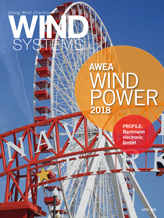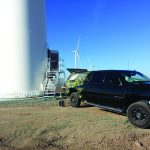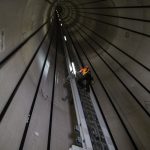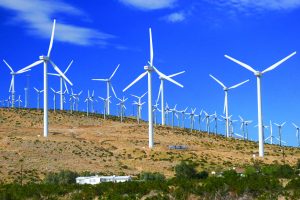Digitalization may mean something different depending on who you are talking to in the wind industry. For some, digitalization is about getting ahead of unplanned failures and focusing on the operations and maintenance (O&M) problems that occur annually in a fleet. For others, it may be converting analog turbine data, like maintenance records, to digital data so they can be further analyzed. For others, it’s making a digital model of an asset to reduce capital expenses through economies of scale. At Sentient Science, digitalization is converting the design, material, operational, and maintenance data into digital format, applying advanced analytics and providing the best prediction capabilities for life and health of assets and fleets. That information is then used by customers to make business decisions for cost reduction and better forecast planning.
IRENA Report
According to the International Renewable Energy Agency (IRENA), wind-turbine cost reductions in the last two decades, for both onshore and offshore wind turbines, have been achieved already by economies of scale and learning effects as installed capacity has grown. LCOE of wind has been reduced further through increasing turbine height and rotor diameters.
The larger blades and hubs may mean higher torque and loading conditions on the critical components within the drivetrain. This shifts the digitalization strategy from increasing the installed capacity to improving the operational availability of the fielded turbines.

Gearboxes typically represent 13 percent to 15 percent of wind-turbine costs, according to the IRENA report. Some gearbox failure rates range between 4.5 percent to 8 percent in a fleet ahead of the gearbox’s 20-year design life. That’s because there is a major difference between physical testing of critical drivetrain components and the actual loading conditions seen in operation.
Sentient Science calculated a difference of as much as 68 percent between a physical test and live operational data.
The discovery was made by validating Sentient’s materials science models against actual fielded maintenance reports.
The reason for the difference in life is because physical testing is limited in the number of data points that can be tested because of cost and time.
In addition, what happens in a laboratory under controlled parameters can be different from the unpredictable and harsh environments experienced in the field.
Beyond the Digital Model
Therefore, digitalization goes beyond making a digital model of an asset for economies of scale, and it goes beyond using big data applications to catch impending failures in the field.
It involves simulating how the materials used in design respond to the actual operating conditions experienced in the field. This is done by converting the data into a digital format called a DigitalClone, applying materials science-based analytics to critical components of the drivetrain, and then measuring the true-life expectancy of the asset. By combining the materials model with the empirical data from the field, the behavior of the asset tells the operator a different story from the design and physical testing that was done before going to market.
It tells the operator how that asset will really perform in the field under a broad range of operating conditions. The same type of wind turbine, with the same type of gearbox, may perform vastly different depending on location and wind regimes. The combinations of major component OEMs within the turbines can vary, especially as assets are exchanged over time and different models used as replacement, furthering the variation.

For example, one wind farm with moderate wind conditions may experience far less failures in their fleet from another wind farm that lives in dynamic conditions with high turbulence and sheer rates. The same wind-turbine model by design and manufacturing process may have different failure rates. The bearings and gears selected for use in the gearbox contributes to the variation of failure rate.
When the operator understands the failure rates of their assets at the major system and component level, life extension actions can be taken to achieve savings of up to 13 percent of revenues. The data from merging materials science and data science enables informed decisions beyond O&M.
When looking at just short-term failure rates, a planning horizon is on average between one week and one month.
There is little life extension that can be gained in this timeframe; however, optimization of site resources can be achieved, including better visibility into the equipment and manpower needed for the job.
Medium- and long-term prognostics, ranging from one year to five years and five-plus years, respectively, can be used for asset management, risk reduction, and increased availability of field assets.
Consider looking at industries who have successfully integrated digitalization, such as Uber and Airbnb. They use digitized information to create new sources of revenue and cost reduction; sometimes a completely new way to look at how business gets transacted.
Uber and Airbnb transformed the taxi and hotel industries through economies of scale and enabling transactions in a platform, which may have implications in renewable energy.
Imagine connecting operators, OEMs, and suppliers in a platform with the needs and availability communicated almost seamlessly.
Multiyear Budgeting and Forecasting
Visibility to one- to five-year failure rates enables multiyear budgeting and forecasting for aftermarket parts to keep in stock. Inventory reduction has substantial value with the ability to shift to Just in Time planning.

This planning method is facilitated with knowledge of the failure rates of the major systems and critical components 12 months to five years in advance. Additionally, strategic partnerships with suppliers and other operators can be developed for maximum buying power that reduce capital expenses through economies of scale and accurate forecasting. It is also possible to correctly size insurance coverage and defend warranty and serial defect claims.
To gain significantly more savings from O&M optimization, operators have to look at applying digitalization to several areas of the business as a way to offer more substantial return on investment. For example, inventory carrying charge reductions and better terms and conditions with suppliers.
Sentient has calculated that a savings of up to 13 percent of revenue can be achieved when looking at the various business units that can benefit from using long term forecasting and budgeting to lower the cost of operations.































